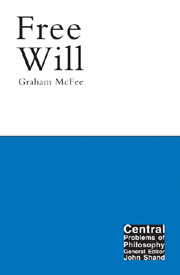Book contents
- Frontmatter
- Contents
- Preface and acknowledgements
- 1 Free will: the issue
- 2 Determinism: exposition
- 3 Determinism: qualifications and clarifications
- 4 Libertarianism: two varieties
- 5 Compatibilism I: the “utilitarian” position
- 6 Compatibilism II: the two-language view
- 7 The irrelevance of determinism
- 8 The very idea of causal necessity
- 9 Conclusions and reflections on philosophical method
- Appendix: chaos theory and determinism
- Notes
- A guide to further reading
- Bibliography
- Index
2 - Determinism: exposition
- Frontmatter
- Contents
- Preface and acknowledgements
- 1 Free will: the issue
- 2 Determinism: exposition
- 3 Determinism: qualifications and clarifications
- 4 Libertarianism: two varieties
- 5 Compatibilism I: the “utilitarian” position
- 6 Compatibilism II: the two-language view
- 7 The irrelevance of determinism
- 8 The very idea of causal necessity
- 9 Conclusions and reflections on philosophical method
- Appendix: chaos theory and determinism
- Notes
- A guide to further reading
- Bibliography
- Index
Summary
Introduction
In Chapter 1 we saw how a common-sense account of the life and activity of human beings builds in the conception of humans as free agents. How might that position be attacked or undermined? Chapter 1 identified the protagonist of such an attack as the determinist: but what precisely is his or her position? As the term is used here, a determinist disputes the viability of the contrasts mentioned in Chapter 1: he urges that the language of action is based on the contrasts identified there (pp. 1–4), contrasts that prove (on investigation) to be spurious. But why should someone believe that such seemingly fundamental contrasts, say, between someone doing something and something happening to one, were actually spurious? Our first task must be to articulate the determinist position as persuasively as we can.
The central thought is that what humans do can be explained, or at least described, using remarks from the “hard sciences”, as we noted in Chapter 1. As a result, what humans do will have the same kind of predictability (in principle) as other happenings have, although perhaps of greater complexity. The interest of determinism lies in its offering the view that (on account of the predictability in principle of human behaviour) all talk of choosing to do this or that is, on investigation, mistaken or misguided. That is to say, the determinist urges that human behaviour could be described solely in causal terms (perhaps in terms of movement of the body): and, moreover, it should be described in those sorts of ways if we are to be consistent.
- Type
- Chapter
- Information
- Free Will , pp. 19 - 34Publisher: Acumen PublishingPrint publication year: 2000

